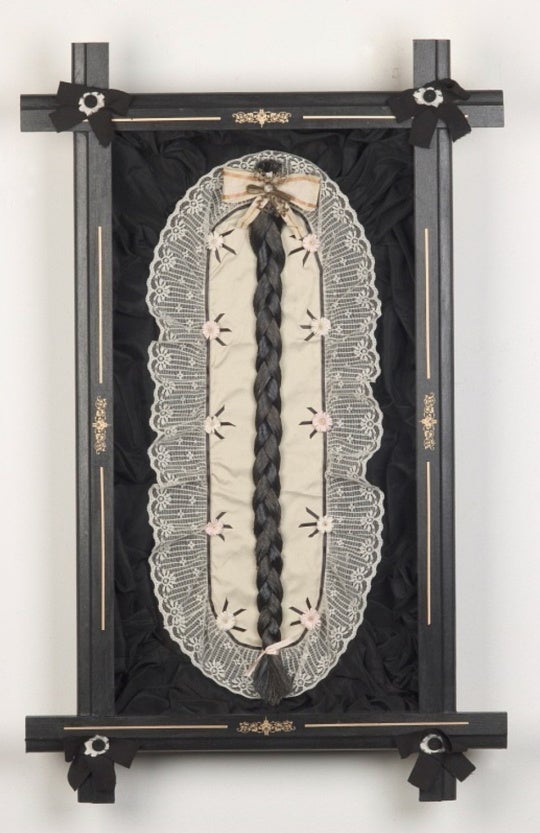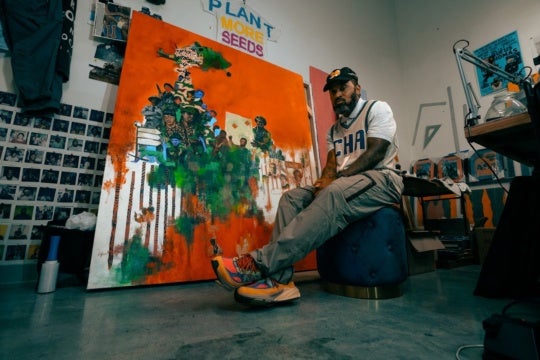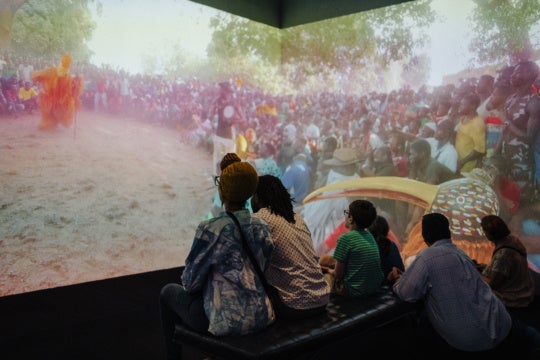
“B-Sides: Musicians as Photographers,” on view at Heron Arts in San Francisco through October 1, examines the breadth and depth of the innate drive to create by highlighting the photographic works of artists known principally as musicians. Interestingly, the music-making serves not as a springboard into the visual arts, but as a sonic counterpart—the flip side to his or her creative vision.
Curated by New Orleans photographer Sean Yseult, who first garnered acclaim as the bass player for White Zombie, the exhibition features nine artists showing about eight pieces each. In addition to Yseult, participants include blues legend Henry Butler, Dave Catching (Eagles of Death Metal), Chris Coleman (Kings of Leon), Greg Dulli (the Afghan Whigs), Louviere + Vanessa (Quaalords), Moby, Pat Sansone (Wilco), and Mike Watt (the Minutemen, Iggy and the Stooges).
Like their music, these artists’ pictures span genres, encompassing everything from spontaneous shots of daily life to tightly choreographed vignettes. What they share, however, is an unmistakable narrative quality—sometimes direct but often ambiguous. Further, they all reveal a penchant for, as Yseult phrases it, “the strange and the beautiful.”
Yseult didn’t set out to assemble a group of artists from specific locales, but as fate would have it, the participants emerged from three of the country’s major cultural centers: New Orleans, Nashville, and the Los Angeles area. “It was purely coincidental,” says Yseult, “but on reflection, you have America’s top three music cities…so it makes perfect sense.”

Sean Yseult has called New Orleans home for more than two decades, and draws inspiration from the city’s unique spiritual vibe. Her most recent series, Soirée D’Evolution, is loosely based on actual events surrounding a wickedly decadent secret-society gathering in 1873 New Orleans. Reminiscent of 17th-century Dutch still lifes, these present-day tableaux vivants depict heady, baroque scenes awash in such historically ubiquitous iconography as skulls, feathers, candles, and food and drink in various stages of consumption. The large-scale, high-contrast color prints punctuate the gallery space with a kinetic intensity, in effect carving out their own environment.
Greg Dulli photographs vast and intimate spaces in New Orleans and around the globe. His richly hued prints amplify the atmosphere with saturated colors and concentrated light juxtapositions, adding a surreal—at times ethereal—layer to the meticulously framed compositions. Beautiful but also unsettling, the landscapes and city scenes are subtly off kilter, as if teetering on the brink. The open narratives lend a sense of uncertainty, leaving viewers to wonder what lies just outside the scope of the lens.

Blind from birth, New Orleans native Henry Butler is consummately adept at accessing the deeper parts of sensory perception. With a highly evolved creative instinct, he relies on listening to and feeling the mood and actions within his environment to compose photographs that are, as he writes, “partly intuitive and a bit intellectual.” Enduringly, people are Butler’s favorite subject matter. His portraits—most notably those featuring flamboyant Mardi Gras participants—seem to speak from the inside out, uncovering the essence of each figure while distilling their larger stories into poignant glimpses of the everyday.

Interested in exploring the tangible convergence of sight and sound, Jeff Louviere and Vanessa Brown have engineered a process by which music manifests as an abstract image. The New Orleans couple employs a spectrograph to create a frequency representing one of the 12 music notes, then record the resulting visual signal. The tactile, process-based designs are printed and laid atop gold leaf before receiving multiple coatings of resin. The refined pieces exhibit a chaotic symmetry that delicately reverberates across and through each surface.
Swathed in the sultry warmth associated with his native South, Pat Sansone’s workaday subjects become dynamic as they move in and out of shadows, simultaneously harnessing and emitting light. Shot with the iconic Polaroid, the photos mine a sentimental connection to our collective history, while also channeling the concept of the snapshot in its truest contemporary form. Fellow Nashville artist Chris Coleman imbues his nature-inspired scenes with silhouettes and shadows that evoke an ambient stillness, even as a quiet effervescence bubbles just under the surface. Soft textures and tones carry the photos into a dreamlike state, where positive and negative space glide in tandem across the picture plane.

Dave Catching’s black-and-white prints artfully document layers of history as they converge, both in his home of Joshua Tree, and as far afield as Jerusalem. With velvety tonal effects, the elegant compositions capture the intrinsic beauty and potential energy encapsulated in both manmade and natural objects. Conversely, Mike Watt’s portfolio consists of locally inspired scenes around his home of San Pedro, California. With ultra-bright colors and simple yet striking compositions, he spins everyday imagery into arresting, often dramatic, scenes that shimmer and melt into the surface.
Based in Los Angeles, Moby brings to his work a pointed introspection, informed by the cumulative effects of life on the road and in the public eye. His carefully constructed scenarios offer a view into a world that is at once familiar and plagued—musings on life in a post-apocalyptic realm. Dynamic, unyielding angles combine with penetrating light to hold viewers at a distance—perhaps a welcome reprieve from entering the bizarre though intriguing alternative realm he has created.

Photography and music materialize as independent yet parallel endeavors within this group of artists. It becomes evident, however, that the desire to give voice to a vision serves as a common, fundamental motivation to create. For like music, photographs transport and suspend. They engage the senses, challenge the mind, and transcend the stasis of reality.
“B-Sides” runs through October 1. Curator Sean Yseult attended the North Carolina School of the Arts, and earned her BFA in photography and graphic design from Parsons School of Design before going on to play music professionally, and finally settling in New Orleans to pursue her art full time.
Elizabeth L. Delaney is a freelance arts writer and publications editor. She has written for Art Papers, Art Lies, and Southwest Art magazines, and regularly pens press releases, catalogue essays, and other materials for galleries, artists, and nonprofit arts organizations.




